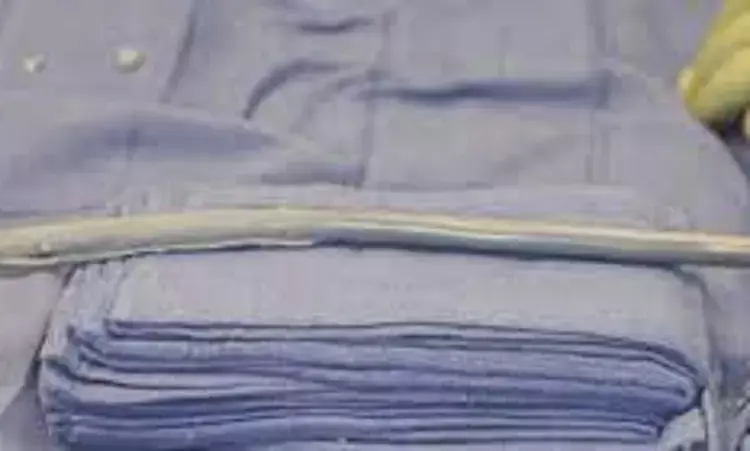- Home
- Medical news & Guidelines
- Anesthesiology
- Cardiology and CTVS
- Critical Care
- Dentistry
- Dermatology
- Diabetes and Endocrinology
- ENT
- Gastroenterology
- Medicine
- Nephrology
- Neurology
- Obstretics-Gynaecology
- Oncology
- Ophthalmology
- Orthopaedics
- Pediatrics-Neonatology
- Psychiatry
- Pulmonology
- Radiology
- Surgery
- Urology
- Laboratory Medicine
- Diet
- Nursing
- Paramedical
- Physiotherapy
- Health news
- Fact Check
- Bone Health Fact Check
- Brain Health Fact Check
- Cancer Related Fact Check
- Child Care Fact Check
- Dental and oral health fact check
- Diabetes and metabolic health fact check
- Diet and Nutrition Fact Check
- Eye and ENT Care Fact Check
- Fitness fact check
- Gut health fact check
- Heart health fact check
- Kidney health fact check
- Medical education fact check
- Men's health fact check
- Respiratory fact check
- Skin and hair care fact check
- Vaccine and Immunization fact check
- Women's health fact check
- AYUSH
- State News
- Andaman and Nicobar Islands
- Andhra Pradesh
- Arunachal Pradesh
- Assam
- Bihar
- Chandigarh
- Chattisgarh
- Dadra and Nagar Haveli
- Daman and Diu
- Delhi
- Goa
- Gujarat
- Haryana
- Himachal Pradesh
- Jammu & Kashmir
- Jharkhand
- Karnataka
- Kerala
- Ladakh
- Lakshadweep
- Madhya Pradesh
- Maharashtra
- Manipur
- Meghalaya
- Mizoram
- Nagaland
- Odisha
- Puducherry
- Punjab
- Rajasthan
- Sikkim
- Tamil Nadu
- Telangana
- Tripura
- Uttar Pradesh
- Uttrakhand
- West Bengal
- Medical Education
- Industry
Antibiotic bone cement coated implant effective and feasible primary treatment of infectious bone defects

Linhu Wang et al conducted a study to investigate the clinical efficacy of antibiotic bone cement-coated implants compared with external fixations for treating infected bone defects. It was conducted at ‘Department of Orthopaedics, Second Affliated Hospital, Air Force Medical University, Xinsi Rd, Xi, Shaanxi, China’. The article has been published in ‘International Orthopaedics.’
Infectious bone defects are mostly caused by open fractures with a serious contamination, infection after internal fixation of fractures, and haematogenous osteomyelitis. The treatment involves both infection control and repair of bone defects. It is a challenge for clinicians to repair bone defects in the presence of infection.
The authors retrospectively enrolled 119 patients with infected bone defects in our hospital, of which 56 were treated with antibiotic bone cement–coated implants and 63 were with external fixation.
The diagnosis of infected bone defects was mainly on the basis of history, signs, and symptoms including localized pain and swelling, imaging studies (X-ray, computed tomography, radionuclide bone scan, and magnetic resonance imaging) showing bone destruction or changes, microbiology, histopathology, and laboratory tests. The diagnosis was made after comprehensive consideration by clinicians, and the histopathological examination was the gold standard.
Key findings of the study were:
• The pre-operative and post-operative haematological indexes were tested to assess the infection control; the postoperative CRP level in the internal fixation group was lower than that in the external fixation group.
• No statistical significance was found in the rate of infection recurrence, loosening and rupture of the fixation, and amputation between the two groups.
• Twelve patients in the external fixation group had pin tract infection.
• In the evaluation of the Paley score scale, bone healing aspect revealed no significant difference between the two groups, while in the limb function aspect, antibiotic cement–coated implant group showed a much better score than the external fixation group (P=0.002).
• The most commonly isolated monomicrobial agent was Enterobacter cloacae in both groups
• The anxiety evaluation scale result also showed lower score in the antibiotic cement implant group (P <0.001).
The authors concluded that – “based on the results of the study, we believed that the antibiotic bone cement–coated implant was a feasible fixation method for the primary treatment of infectious bone defects. It could provide better limb stability and patient compliance and reduce the psychological burden of patients compared with the external fixation, thereby improving the patient’s quality of life without increasing the rate of infection recurrence.”
Further reading:
Efficacy comparison of antibiotic bone cement–coated implants and external fixations for treating infected bone defects. Linhu Wang, Shuaikun Lu et al, International Orthopaedics (2023) 47:1171–1179, https://doi.org/10.1007/s00264-023-05727-8
MBBS, Dip. Ortho, DNB ortho, MNAMS
Dr Supreeth D R (MBBS, Dip. Ortho, DNB ortho, MNAMS) is a practicing orthopedician with interest in medical research and publishing articles. He completed MBBS from mysore medical college, dip ortho from Trivandrum medical college and sec. DNB from Manipal Hospital, Bengaluru. He has expirence of 7years in the field of orthopedics. He has presented scientific papers & posters in various state, national and international conferences. His interest in writing articles lead the way to join medical dialogues. He can be contacted at editorial@medicaldialogues.in.
Dr Kamal Kant Kohli-MBBS, DTCD- a chest specialist with more than 30 years of practice and a flair for writing clinical articles, Dr Kamal Kant Kohli joined Medical Dialogues as a Chief Editor of Medical News. Besides writing articles, as an editor, he proofreads and verifies all the medical content published on Medical Dialogues including those coming from journals, studies,medical conferences,guidelines etc. Email: drkohli@medicaldialogues.in. Contact no. 011-43720751


